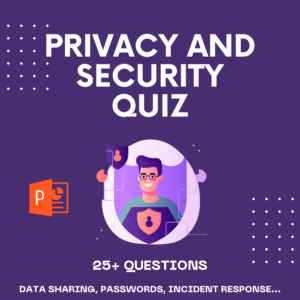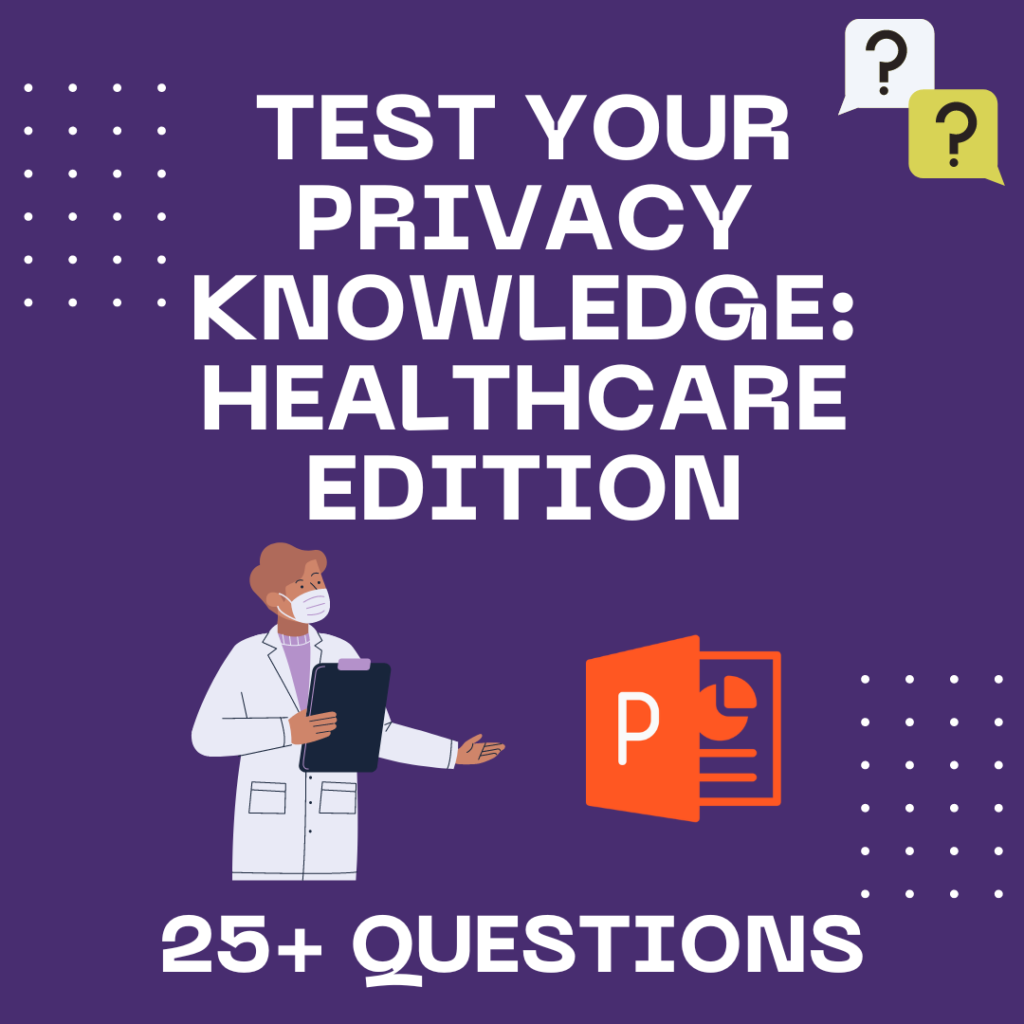Security awareness training is a crucial aspect of any organization’s security program. It helps employees understand the importance of security and how they can contribute to maintaining a secure environment. One effective way to test the effectiveness of security awareness training is through quizzes. A security awareness training quiz with answers can help organizations evaluate the knowledge of their employees and identify areas where additional training may be necessary.
Fundamentals of Security Awareness is the first topic that should be covered in a security awareness training quiz. This includes basic concepts such as identifying phishing emails, creating strong passwords, and keeping software up to date. Designing an Effective Quiz is also important as it ensures that the quiz questions are relevant and engaging. Sample Quiz Questions can be used to test employees’ understanding of security concepts and evaluate the effectiveness of the training. Answers and Explanations should also be provided to help employees understand why certain answers are correct and others are not.
Key Takeaways
- Security awareness training is crucial for maintaining a secure environment in any organization.
- A security awareness training quiz with answers can help evaluate the effectiveness of the training and identify areas where additional training may be necessary.
- Fundamentals of Security Awareness, Designing an Effective Quiz, Sample Quiz Questions, and Answers and Explanations are important components of a security awareness training quiz.
Fundamentals of Security Awareness
Concepts of Information Security
Information security is the practice of protecting sensitive information from unauthorized access, use, disclosure, disruption, modification, or destruction. It involves a range of measures, including physical, technical, and administrative controls, to ensure the confidentiality, integrity, and availability of information.
Some of the key concepts of information security include:
- Confidentiality: ensuring that information is only accessible to authorized individuals or systems.
- Integrity: maintaining the accuracy and consistency of information.
- Availability: ensuring that information is accessible when needed.
- Authentication: verifying the identity of individuals or systems accessing information.
- Authorization: granting individuals or systems the appropriate level of access to information.
Importance of Security Awareness Training
Security awareness training is an essential component of any organization’s information security program. It helps employees understand the risks and threats facing the organization, and teaches them how to identify and respond to potential security incidents.
Some of the benefits of security awareness training include:
- Reduced risk of security incidents: by educating employees on best practices for information security, organizations can reduce the likelihood of security incidents caused by human error or negligence.
- Improved compliance: many regulations and standards require organizations to provide security awareness training to employees.
- Increased security culture: security awareness training can help promote a culture of security within the organization, where employees understand the importance of information security and take an active role in protecting sensitive information.
Designing an Effective Quiz
Security awareness training quizzes are an essential component of any comprehensive security awareness program. A well-designed quiz can help employees retain important security information and reinforce good security practices.
Key Components of a Security Quiz
You may wonder, how effective is security awareness training? An effective security quiz should include the following components:
- Relevant Content: The quiz questions should cover topics that are relevant to the employees’ job roles and the organization’s security policies.
- Clear Objectives: The quiz should have clear objectives that are aligned with the organization’s security goals.
- Engaging Format: The quiz should be engaging and interactive, with a mix of different question types such as multiple-choice, true/false, and scenario-based questions.
- Timely Feedback: The quiz should provide immediate feedback to employees, highlighting correct and incorrect answers and explaining the reasoning behind each answer.
- Regular Updates: The quiz should be updated regularly to reflect changes in the organization’s security policies and emerging threats.
Quiz Structure and Delivery Methods
There are different ways to structure and deliver a security quiz, depending on the organization’s needs and resources. Some common quiz structures and delivery methods include:
- Online Quizzes: Online quizzes can be delivered through a learning management system or an online quiz tool. They can be accessed by employees at any time and from any location, making them a convenient option for remote workers.
- In-person Quizzes: In-person quizzes can be delivered during security training sessions or team meetings. They allow for real-time feedback and discussion, which can enhance employees’ understanding of security concepts.
- Gamified Quizzes: Gamified quizzes use game elements such as points, badges, and leaderboards to make the quiz more engaging and fun. They can be delivered online or in-person and are particularly effective for younger employees.
Designing an effective security quiz requires careful consideration of the quiz components and delivery methods. By creating a quiz that is relevant, engaging, and up-to-date, organizations can help employees develop a strong security awareness mindset and reduce the risk of security incidents.
Sample Quiz Questions
Security awareness training quizzes are an effective way to reinforce security best practices and identify knowledge gaps among employees. The following sample quiz questions cover various topics related to security awareness.
Phishing and Social Engineering
- What is phishing?
A. A type of fishing
B. A fraudulent attempt to obtain sensitive information
C. A type of social engineering attack
D. A type of malware
Answer: B
- What is social engineering?
A. A type of malware
B. A fraudulent attempt to obtain sensitive information
C. A type of fishing
D. A type of physical security
Answer: B
- What are some common signs of a phishing email?
A. Urgent language and requests for personal information
B. Typos and grammatical errors
C. Suspicious links and attachments
D. All of the above
Answer: D
Password Security
- What is a strong password?
A. A password that is easy to remember
B. A password that contains at least 8 characters, including uppercase and lowercase letters, numbers, and symbols
C. A password that contains only letters
D. A password that is written down and kept in a secure location
Answer: B
- What is password reuse?
A. Using the same password for multiple accounts
B. Changing your password frequently
C. Using a different password for each account
D. Sharing your password with others
Answer: A
- What is two-factor authentication?
A. Using two different passwords for the same account
B. Using a password and a PIN
C. Using a password and a security token
D. Using two different authentication methods to verify identity
Answer: D
Physical Security
- What is tailgating?
A. Following too closely behind another vehicle
B. Allowing unauthorized access to a secure area by following an authorized person
C. Using a physical key to access a secure area
D. Using a password to access a secure area
Answer: B
- What is shoulder surfing?
A. Looking over someone’s shoulder to obtain sensitive information
B. Watching a security camera feed
C. Using binoculars to spy on someone
D. None of the above
Answer: A
- What is clean desk policy?
A. Keeping your desk clean and organized
B. Locking your desk drawers
C. Ensuring that sensitive information is not left out in the open
D. All of the above
Answer: C
By incorporating these types of questions into security awareness training quizzes, organizations can help their employees better understand security best practices and reduce the risk of security incidents.
Answers and Explanations
Answer Key
The following are the correct answers to the security awareness training quiz:
- B
- C
- A
- D
- A
- C
- B
- D
- A
- B
Rationale Behind Correct Answers
- B – Passwords should be changed periodically to prevent unauthorized access. Changing passwords every 90 days is a good practice.
- C – A strong password should have a combination of upper and lowercase letters, numbers, and special characters. This makes it harder for attackers to guess or crack the password.
- A – Phishing is a type of social engineering attack that tricks users into giving away sensitive information. Users should be cautious of emails or messages that ask for personal information or contain suspicious links.
- D – Two-factor authentication adds an extra layer of security by requiring users to provide two forms of identification, such as a password and a code sent to their phone.
- A – Public Wi-Fi networks are often unsecured, which means that anyone on the same network can potentially access your device and steal your information. Users should avoid using public Wi-Fi for sensitive activities, such as online banking or shopping.
- C – Social engineering is a tactic used by attackers to manipulate users into giving away sensitive information or performing actions that benefit the attacker. Users should be cautious of unsolicited phone calls or messages asking for personal information.
- B – Malware is a type of software designed to harm or exploit devices. Users should be cautious of downloading or installing software from untrusted sources.
- D – Physical security is an important aspect of overall security. Users should lock their screens when stepping away from their devices to prevent unauthorized access.
- A – Backing up data regularly is important to prevent data loss in case of a device failure or attack. Users should back up their data to an external hard drive or cloud storage.
- B – Security awareness training is an important aspect of overall security. It helps users understand the risks and best practices for securing their devices and data.
Evaluating Training Effectiveness
Security awareness training is essential for employees to stay vigilant against potential cyber threats. However, evaluating the effectiveness of training is equally important to ensure that employees have learned and retained the necessary knowledge to protect sensitive data and systems.
Metrics for Assessment
One way to evaluate the effectiveness of security awareness training is by using metrics. Metrics can be used to measure the progress of employees, identify knowledge gaps, and determine the overall effectiveness of the training program. Some common metrics used for assessing training effectiveness include:
- Pre- and post-training assessments: These assessments can help determine how much knowledge employees have gained from the training and identify areas that need improvement.
- Phishing simulation tests: These tests can help determine if employees can identify and report phishing attempts.
- Compliance metrics: These metrics can help determine if employees are following security policies and procedures.
Using metrics to assess training effectiveness provides valuable insights into the effectiveness of the training program and can help identify areas for improvement.
Feedback and Improvement Strategies
Another way to evaluate the effectiveness of security awareness training is by gathering feedback from employees. Feedback can help identify areas where employees feel they need more training or areas where the training was not effective. Some feedback and improvement strategies include:
- Employee surveys: Surveys can help gather feedback from employees on the effectiveness of the training program and identify areas for improvement.
- Continuous training: Providing ongoing training can help reinforce the knowledge gained from the initial training and help employees stay up-to-date with the latest threats and security best practices. Earlier we wrote an article on why you should repeat awareness training regularly.
- Customized training: Customizing training to specific job roles or departments can help ensure that employees receive the training that is most relevant to their job responsibilities.
Using feedback and improvement strategies can help ensure that the training program is effective and meets the needs of the organization and its employees.
Advanced Topics in Security Awareness
Emerging Threats
As technology continues to advance, new threats to security emerge. It is important for organizations to stay up-to-date on the latest threats and vulnerabilities in order to best protect themselves. Some emerging threats include:
- Ransomware: Malicious software that encrypts a victim’s files and demands payment in exchange for the decryption key.
- IoT Attacks: The increasing number of Internet of Things (IoT) devices in use provides more opportunities for cyber criminals to gain access to sensitive information.
- Social Engineering: The use of psychological manipulation to trick individuals into divulging confidential information.
To combat these emerging threats, organizations should ensure that their security awareness training programs are constantly updated to reflect the latest threats and vulnerabilities. Employees should be trained to recognize and respond to these threats appropriately.
Continuous Education Strategies
Effective security awareness training is not a one-time event, but rather an ongoing process. Continuous education strategies can help reinforce the importance of security awareness and keep employees up-to-date on the latest threats and best practices. Some strategies include:
- Phishing Simulations: Regular phishing simulations can help employees recognize and avoid phishing emails.
- Gamification: Turning security awareness training into a game can make it more engaging and effective.
- Case Studies: Real-life examples of security breaches can help employees understand the consequences of poor security practices.
By implementing continuous education strategies, organizations can ensure that their employees are well-equipped to protect against security threats.
Legal and Compliance Considerations
Regulatory Requirements
Security awareness training is not only important for protecting an organization’s data and assets, but it is also a regulatory requirement for many industries. Regulations such as HIPAA, PCI DSS, and GDPR require organizations to provide regular security awareness training to their employees to ensure compliance with data protection laws and regulations.
HIPAA, for example, requires healthcare organizations to provide regular security awareness training to their employees to ensure the confidentiality, integrity, and availability of electronic protected health information (ePHI). PCI DSS requires organizations that handle credit card data to provide security awareness training to their employees to ensure compliance with the standard’s requirements.
Data Protection Laws
In addition to regulatory requirements, organizations must also consider data protection laws when providing security awareness training. Data protection laws such as the General Data Protection Regulation (GDPR) require organizations to implement appropriate technical and organizational measures to ensure the security of personal data.
Security awareness training is an essential part of these measures, as it helps employees understand the importance of protecting personal data and the potential consequences of a data breach. Organizations must ensure that their security awareness training covers the requirements of data protection laws and that employees are aware of their responsibilities when it comes to protecting personal data.



